Papers by Dana (Wingfield) Briscoe
Journal of the Royal Society of New Zealand
2021 IEEE Symposium Series on Computational Intelligence (SSCI), Dec 5, 2021
h i g h l i g h t s Pre-trained deep Convolutional Neural Networks (DCNN) were used for crack det... more h i g h l i g h t s Pre-trained deep Convolutional Neural Networks (DCNN) were used for crack detection. Pavement images sampled from the FHWA/LTPP database were used as datasets. The truncated VGG-16 DCNN was used as a deep feature generator for road images. Various machine learning classifiers were trained using the semantic image vectors. A neural network classifier trained on deep transfer learning vectors gave the best results.
Journal of the Royal Society of New Zealand
2021 36th International Conference on Image and Vision Computing New Zealand (IVCNZ)
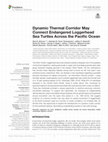
Frontiers in Marine Science, 2021
The North Pacific Loggerhead sea turtle (Caretta caretta) undergoes one of the greatest of all an... more The North Pacific Loggerhead sea turtle (Caretta caretta) undergoes one of the greatest of all animal migrations, nesting exclusively in Japan and re-emerging several years later along important foraging grounds in the eastern North Pacific. Yet the mechanisms that connect these disparate habitats during what is known as the “lost years” have remained poorly understood. Here, we develop a new hypothesis regarding a possible physical mechanism for habitat connectivity – an intermittent “thermal corridor” – using remotely sensed oceanography and 6 juvenile loggerhead sea turtles that formed part of a 15 year tracking dataset of 231 individuals (1997–2013). While 97% of individuals remained in the Central North Pacific, these 6 turtles (about 3%), continued an eastward trajectory during periods associated with anomalously warm ocean conditions. These few individuals provided a unique opportunity to examine previously unknown recruitment pathways. To support this hypothesis, we employed...
Frontiers in Marine Science, 2018
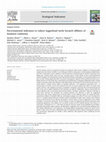
Ecological Indicators, 2019
Extreme climatic events are expected to become more frequent under current conditions of increasi... more Extreme climatic events are expected to become more frequent under current conditions of increasing global temperatures and climate variability. A key challenge of fisheries management is understanding and planning for the effect of anomalous oceanic conditions on the distributions of protected species and their interactions with fishing gear. Atypical marine states can cause non-target species to shift outside of their normal distribution patterns, leading to unwanted bycatch events that threaten fisheries sustainability. Environmental indicators can serve as early warning signals that allow for proactive management responses before significant bycatch occurs. Marine heatwaves in the Pacific have caused shifts in the distributions of endangered loggerhead turtles (Caretta caretta), increasing overlap with California's Drift Gillnet fishery and thereby the risk of turtle bycatch events. To reduce bycatch, a fishery closure offshore of Southern California-The Loggerhead Conservation Area-Is enacted when an El Niño event has been declared and local sea surface temperatures (SSTs) are warmer than normal. However, this regulation was based on qualitative assessment of bycatch that occurred during past El Niño events, and no explicit threshold for SST anomalies was defined. Additionally, closures enacted under the current regulation rely on structured expert decision-making. Providing a quantitative indicator could help to refine future decisions. We developed and evaluated potential new indicators to guide the Loggerhead Conservation Area closure timing based on thermal indices in three different regions: the equatorial Pacific, regional areas offshore of Southern California, and temperate pelagic areas off the US west coast. Our objectives were to: 1) quantify thermal indicators and their respective thresholds to guide closure timing, and 2) hindcast closure scenarios based on these indicator thresholds to evaluate efficacy in terms of opportunity costs to fishers and ability to avoid turtle interactions. The best indicator in terms of avoiding historical turtle interactions while minimizing opportunity cost to fishers was a six-month average local SST anomaly indicator with closures enacted above a threshold of 0.77°C. This result can improve upon the current closure guidelines by providing a quantified and spatially-explicit indicator and threshold to supplement the structured decision-making process. Our analysis demonstrates a novel approach to developing fisheries management strategies for species with a paucity of data. Issues with data comprehensiveness are frequently present in fisheries management exercises, and precautionary approaches are needed to allow adherence with legislation while considering the best available science.
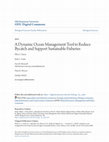
Science advances, 2018
Seafood is an essential source of protein for more than 3 billion people worldwide, yet bycatch o... more Seafood is an essential source of protein for more than 3 billion people worldwide, yet bycatch of threatened species in capture fisheries remains a major impediment to fisheries sustainability. Management measures designed to reduce bycatch often result in significant economic losses and even fisheries closures. Static spatial management approaches can also be rendered ineffective by environmental variability and climate change, as productive habitats shift and introduce new interactions between human activities and protected species. We introduce a new multispecies and dynamic approach that uses daily satellite data to track ocean features and aligns scales of management, species movement, and fisheries. To accomplish this, we create species distribution models for one target species and three bycatch-sensitive species using both satellite telemetry and fisheries observer data. We then integrate species-specific probabilities of occurrence into a single predictive surface, weighin...
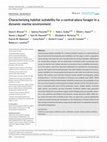
Ecology and evolution, Mar 1, 2018
Characterizing habitat suitability for a marine predator requires an understanding of the environ... more Characterizing habitat suitability for a marine predator requires an understanding of the environmental heterogeneity and variability over the range in which a population moves during a particular life cycle. Female California sea lions () are central-place foragers and are particularly constrained while provisioning their young. During this time, habitat selection is a function of prey availability and proximity to the rookery, which has important implications for reproductive and population success. We explore how lactating females may select habitat and respond to environmental variability over broad spatial and temporal scales within the California Current System. We combine near-real-time remotely sensed satellite oceanography, animal tracking data ( = 72) from November to February over multiple years (2003-2009) and Generalized Additive Mixed Models (GAMMs) to determine the probability of sea lion occurrence based on environmental covariates. Results indicate that sea lion pre...

Proceedings of the Royal Society B: Biological Sciences, 2016
Highly migratory marine species can travel long distances and across entire ocean basins to reach... more Highly migratory marine species can travel long distances and across entire ocean basins to reach foraging and breeding grounds, yet gaps persist in our knowledge of oceanic dispersal and habitat use. This is especially true for sea turtles, whose complex life history and lengthy pelagic stage present unique conservation challenges. Few studies have explored how these young at-sea turtles navigate their environment, but advancements in satellite technology and numerical models have shown that active and passive movements are used in relation to open ocean features. Here, we provide the first study, to the best of our knowledge, to simultaneously combine a high-resolution physical forcing ocean circulation model with long-term multi-year tracking data of young, trans-oceanic North Pacific loggerhead sea turtles during their ‘lost years’ at sea. From 2010 to 2014, we compare simulated trajectories of passive transport with empirical data of 1–3 year old turtles released off Japan (29....
Model-derived relative probability of swordfish presence, hind-cast on Regional Ocean Model outpu... more Model-derived relative probability of swordfish presence, hind-cast on Regional Ocean Model outputs for the period 1st-31st November 2014.
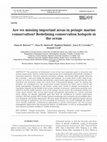
Endangered Species Research, 2016
The protection of biodiversity is one of the most important goals in terrestrial and marine conse... more The protection of biodiversity is one of the most important goals in terrestrial and marine conservation. Marine conservation approaches have traditionally followed the example of terrestrial initiatives. However, patterns, processes, habitats, and threats differ greatly between the 2 systems-and even within the marine environment. As a result, there is still a lack of congruence as to how to best identify and prioritize conservation approaches moving from the static terrestrial and nearshore realm into a more fluid, 3-dimensional pelagic realm. To address this problem, we investigate how the conservation science literature has been used to inform and guide management strategies in the marine system from coastal to pelagic environments. As cumulative impacts on the health of the oceans continue to increase, conservation priorities have shifted to include highly dynamic areas of the pelagic marine system. By evaluating whether priorities match science with current place-based management approaches (i.e. marine protected areas, MPAs), we identify important gaps that must be considered in current conservation schemes. Effective pelagic MPA design requires monitoring and evaluation across multiple physical, biological, and human dimensions. Because many threatened and exploited marine species move through an ephemeral and ever-changing environment, our results highlight the need to move beyond traditional, 2-dimensional approaches to marine conservation, and into dynamic management approaches that incorporate metrics of biodiversity as well as oceanographic features known to promote multilevel, trophic productivity.
Diversity and Distributions, 2019
This is an open access article under the terms of the Creat ive Commo ns Attri bution License, wh... more This is an open access article under the terms of the Creat ive Commo ns Attri bution License, which permits use, distribution and reproduction in any medium, provided the original work is properly cited.
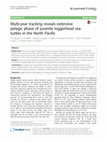
Movement Ecology, 2016
Background: The juvenile stage of loggerhead sea turtles (Caretta caretta) can last for decades. ... more Background: The juvenile stage of loggerhead sea turtles (Caretta caretta) can last for decades. In the North Pacific Ocean, much is known about their seasonal movements in relation to pelagic habitat, yet understanding their multi-year, basin-scale movements has proven more difficult. Here, we categorize the large-scale movements of 231 turtles satellite tracked from 1997 to 2013 and explore the influence of biological and environmental drivers on basin-scale movement. Results: Results show high residency of juvenile loggerheads within the Central North Pacific and a moderate influence of the Earth's magnetic field, but no real-time environmental driver to explain migratory behavior. Conclusions: We suggest the Central North Pacific acts as important developmental foraging grounds for young juvenile loggerhead sea turtles, rather than just a migratory corridor. We propose several hypotheses that may influence the connectivity between western and eastern juvenile loggerhead foraging grounds in the North Pacific Ocean.
Fish and Fisheries, 2017
Ghoti papers Ghoti aims to serve as a forum for stimulating and pertinent ideas. Ghoti publishes ... more Ghoti papers Ghoti aims to serve as a forum for stimulating and pertinent ideas. Ghoti publishes succinct commentary and opinion that addresses important areas in fish and fisheries science. Ghoti contributions will be innovative and have a perspective that may lead to fresh and productive insight of concepts, issues and research agendas. All Ghoti contributions will be selected by the editors and peer reviewed. Etymology of Ghoti George Bernard Shaw (1856-1950), polymath, playwright, Nobel prize winner, and the most prolific letter writer in history, was an advocate of English spelling reform. He was reportedly fond of pointing out its absurdities by proving that 'fish' could be spelt 'ghoti'. That is: 'gh' as in 'rough', 'o' as in 'women' and 'ti' as in palatial.
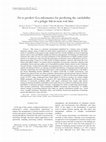
Ecological Applications, 2017
The ocean is a dynamic environment inhabited by a diverse array of highly migratory species, many... more The ocean is a dynamic environment inhabited by a diverse array of highly migratory species, many of which are under direct exploitation in targeted fisheries. The timescales of variability in the marine realm coupled with the extreme mobility of ocean-wandering species such as tuna and billfish complicates fisheries management. Developing eco-informatics solutions that allow for near real-time prediction of the distributions of highly mobile marine species is an important step towards the maturation of dynamic ocean management and ecological forecasting. Using 25 yr (1990-2014) of NOAA fisheries' observer data from the California drift gillnet fishery, we model relative probability of occurrence (presence-absence) and catchability (total catch per gillnet set) of broadbill swordfish Xiphias gladius in the California Current System. Using freely available environmental data sets and open source software, we explore the physical drivers of regional swordfish distribution. Comparing models built upon remotely sensed data sets with those built upon a data-assimilative configuration of the Regional Ocean Modelling System (ROMS), we explore trade-offs in model construction, and address how physical data can affect predictive performance and operational capacity. Swordfish catchability was found to be highest in deeper waters (>1,500 m) with surface temperatures in the 14-20°C range, isothermal layer depth (ILD) of 20-40 m, positive sea surface height (SSH) anomalies, and during the new moon (<20% lunar illumination). We observed a greater influence of mesoscale variability (SSH, wind speed, isothermal layer depth, eddy kinetic energy) in driving swordfish catchability (total catch) than was evident in predicting the relative probability of presence (presence-absence), confirming the utility of generating spatiotemporally dynamic predictions. Data-assimilative ROMS circumvent the limitations of satellite remote sensing in providing physical data fields for species distribution models (e.g., cloud cover, variable resolution, subsurface data), and facilitate broad-scale prediction of dynamic species distributions in near real time.

Deep Sea Research Part II: Topical Studies in Oceanography, 2017
Many highly mobile species are known to use persistent pathways or corridors to move between habi... more Many highly mobile species are known to use persistent pathways or corridors to move between habitat patches in which conditions are favorable for particular activities, such as breeding or foraging. In the marine realm, environmental variability can lead to the development of temporary periods of anomalous oceanographic conditions that can connect individuals to areas of habitat outside a population's usual range, or alternatively, restrict individuals from areas usually within their range, thus acting as ecological bridges or ecological barriers. These temporary features can result in novel or irregular trophic interactions and changes in population spatial dynamics, and, therefore, may have significant implications for management of marine ecosystems. Here, we provide evidence of ecological bridges and barriers in different ocean regions, drawing upon five case studies in which particular oceanographic conditions have facilitated or restricted the movements of individuals from highly migratory species. We discuss the potential population-level significance of ecological bridges and barriers, with respect to the life history characteristics of different species, and inter-and intra-population variability in habitat use. Finally, we summarize the persistence of bridge dynamics with time, our ability to monitor bridges and barriers in a changing climate, and implications for forecasting future climate-mediated ecosystem change.

Uploads
Papers by Dana (Wingfield) Briscoe